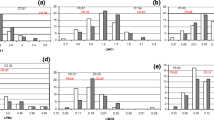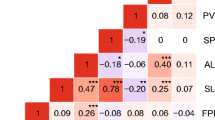Summary
The salt-tolerant cultivated tomato (Lycopersicon esculentum) accession, ‘PI174263’, and a sensitive cv, ‘UCT5’, were crossed to develop reciprocal F1, F2 and BC1 populations for genetic analysis of salt tolerance in tomatoes during seed germination. Variation was partitioned into embryo, endosperm and maternal (testa and cytoplasmic) components. Generation means analysis indicated that there were no significant embryo (additive, dominance or epistatic) effects on germination performance under salt stress. Highly significant endosperm additive and testa dominance effects were detected. The proportion of the total variance explained by the model containing these two components was R2=98.2%. Variance component analysis indicated a large genetic variance with additive gene action as the predominant component. Furhter inspection indicated that this variance was attributable to endosperm additive effects on germinability under salt stress. Narrow-sense heritability was estimated as moderately high. Implications for breeding procedures are discussed.
Similar content being viewed by others
References
Cavalli-Sforza LL (1952) An analysis of linkage in quantitative inheritance. In: Reeve ECR, Waddington CH (eds) Quantitative genetics. HMSO, London, England, pp 135–144
Cook RE (1979) Patterns of juvenile morbidity and recruitment in plants. In: Solbrig OT, Jain S, Johnson GB, Raven PH (eds) Topics in plant population biology. Columbia Univ Press, New York, pp 207–301
Daday H, Binet FE, Grassia A, Peak JW (1973) The effect of environment on heritability and predicted selection response in Medicago sativa. Heredity 31:293–308
Dixon WJ (ed) (1985) BMDP Statistical software. University of California Press, Los Angeles
El Sayed MN, John CA (1973) Heritability studies of tomato emergence at different temperatures. J Am Soc Hortic Sci 98:440–443
Gehan EA (1969) Estimating survival functions from the life table. J Chron Dis 21:629–644
Ginkel MV, Scharen AL (1987) Generation mean analysis and heritabilities of resistance to Septoria tritici in durum wheat. Phytopathology 77:1629–1633
Groot SPC, Karssen CM (1987) Gibberellins regulate seed germination in tomato by endosperm weakening: A study with gibberellin-deficient mutant. Planta 171:525–531
Groot SPC, Kieliszewska-Rokicka B, Vermeer E, Karssen CM (1988) Gibberellin-induced hydrolysis of endosperm cell walls in gibberellin-deficient tomato seeds prior to radicle protrusion. Planta 174:500–504
Haigh AH, Barlow EWR (1987) Water relations of tomato seed germination. Aust J Plant Physiol 14:485–492
Hanson WD (1963) Heritability. In: Hanson WD, Robinson HF, (eds) Statistical genetics and plant breeding. Publ 982 Natl Acad Sci — Natl Res Council. Washington, D.C., pp 125–140
Hayman BI (1958) The separation of epistatic from additive and dominance variation in generation means. Heredity 12:371–390
Johnson GR, Frey KJ (1967) Heritabilities of quantitative attributes of oats (Avena sp) at varying levels of environmental stress. Crop Sci 7:43–46
Jones RA (1986) High salt-tolerance potential in Lycopersicon species during germination. Euphytica 35:575–582
Jones RA (1987) Genetic advances in salt-tolerance. In: Nevins DJ, Jones RA (eds) Tomato Biotechnology. Alan R Liss, New York, pp 125–137
Jones RA, Qualset CO (1984) Breeding crops for environmental stress tolerance. In: Collins GB, Petolino JF (eds) Application of genetic engineering to crop improvement. Nijhoff/Junk Publishers, Holland, pp 305–340
Jones RA, Hashim M, El-Beltagy AS (1988) Developmental responsiveness of salt-tolerant and salt-sensitive genotypes of Lycopersicon. In: Whitehead E, Hutchison F, Timmerman B, Varazy R (eds) Arid lands: today and tomorrow. Westview Press, Boulder, Colorado, pp 765–772
Lee E (1980) Statistical methods for survival data analysis. Wadworth, Lifetime Learning Publ, Belmont, California
Liptay A, Schopfer P (1983) Effect of water stress, seed coat restraint, and abscisic acid upon different germination capabilities of two tomato lines at low temperature. Plant Physiol 73:935–938
Maas EV, Hoffman GS (1977) Crop salt-tolerance current assessment. J Irrig Drain Div (Am Soc Civil Eng). 103:115–134
Mather K, Jinks JL (1971) Biometrical genetics, 2nd ed. Chapman and Hall, London, England
Mather K, Jinks JL (1977) Introduction to biometrical genetics. Chapman and Hall, London, England
Richards RA (1983) Should selection for yield in saline regions be made on saline or non-saline soils? Euphytica 32:431–438
Rosielle AA, Hamblin J (1981) Theoretical aspects of selection for yield in stress and non-stress environments. Crop Sci 21:943–946
Rush DW, Epstein E (1976) Genotypic responses to salinity: differences between salt-sensitive and salt-tolerant genotypes of the tomato. Plant Physiol 57:162–166
Scott SJ, Jones RA (1982) Low temperature seed germination of Lycopersicon species evaluated by survival analysis. Euphytica 31:869–883
Shannon MC (1982) Genetics of salt-tolerance: New challenges. In: San Pietro A (ed) Biosaline research, a look to the future. Plenum Press, New York, pp 271–282
Tal M, Shannon MC (1983) Salt-tolerance in the wild relatives of the cultivated tomato: Responses of Lycopersicon esculentum, L. cheesmannii, L. peruvianum, Solanum pennellii and F1 hybrids to high salinity. Aust J Plant Physiol 10:109–117
Author information
Authors and Affiliations
Additional information
Communicated by A.L. Kahler
Rights and permissions
About this article
Cite this article
Fooland, M.R., Jones, R.A. Genetic analysis of salt tolerance during germination in Lycopersicon . Theoret. Appl. Genetics 81, 321–326 (1991). https://doi.org/10.1007/BF00228671
Received:
Accepted:
Issue Date:
DOI: https://doi.org/10.1007/BF00228671




